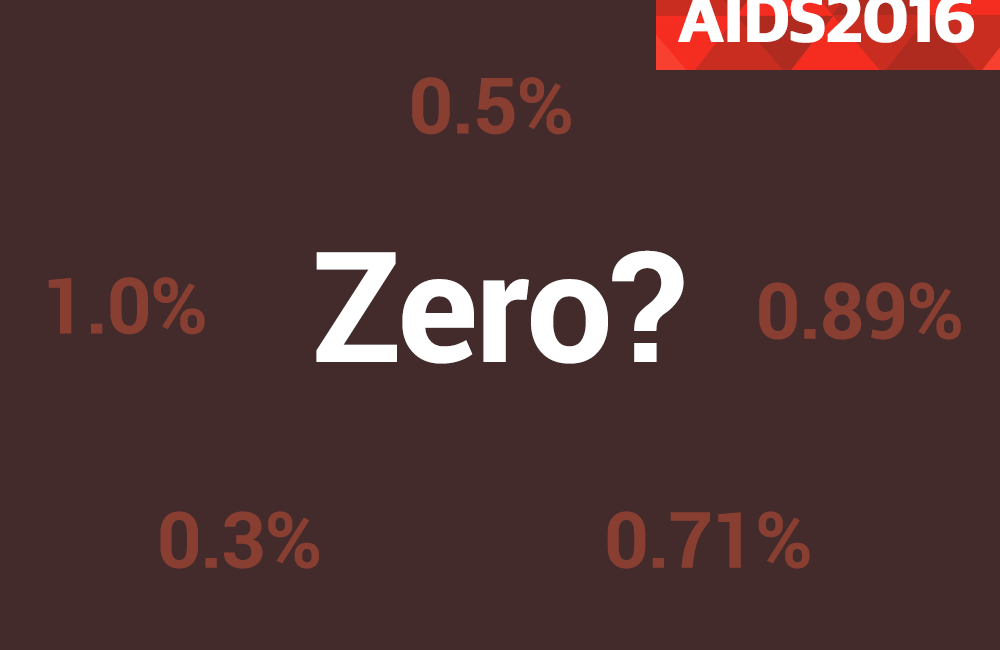
The PARTNER study, which two years ago created headlines by establishing that the chance of an HIV-positive person with an undetectable viral load transmitting their virus was very low and quite possibly zero, released new data at the 21st International AIDS Conference (AIDS 2016) that further refined this estimate.
In 2014 the study found no HIV transmissions between 767 serodiscordant couples, who between them had condomless sex an estimated 44,400 times, where the HIV-positive partner had a viral load under 200 copies/ml.
The latest estimate includes 888 couples, 38% of them gay male couples, who were followed for 1238 couple-years altogether (1.6 years per couple on average), which encompassed an estimated 58,213 sex acts – 31% more than in 2014.
The study involves 75 clinics in 14 European countries. Blood tests and behavioural data are collected every 4 to 6 months. In order to be eligible for the study during each 4 to 6 month period, the couple has to report condomless sex with each other, without using post-exposure prophylaxis (PEP) or pre-exposure prophylaxis (PrEP), at least once during this time, and the HIV-positive partner has to maintain a viral load below 200 copies/ml. Fifty-five (6.2%) of the 888 HIV-positive partners reported a detectable viral load at some point in the study.
Self-reported viral load tended to underestimate viral suppression: 6% of gay men, 13% of heterosexual men and 16% of women thought they had a detectable viral load or did not know it when they were, in fact, undetectable.
The lack of transmissions obviously means that the lowest-likely estimate for the chance of an undetectable HIV-positive partner transmitting HIV is zero. But the longer time span and larger number of sex acts included means that the highest-likely estimate of transmission falls, simply because the precision of the estimate rises – the picture portrayed by the data gets less fuzzy, so to speak.
Thus in 2014 the highest-likely estimate for the chance of between-couple transmission via any sex was 0.5%; the new data narrows this ‘upper confidence interval bound’ to 0.3%. But it is important to keep in mind that, as presenter Alison Rodger said, zero transmissions means that “the estimated rate of transmission is zero”.
The highest-likely chance of transmission via anal sex similarly narrows down from 1.0% to 0.71% a year in everyone and 0.89% in gay men (incidentally, 20% of the 522 couple-hours of anal sex in the study were contributed by heterosexuals). And it does not mean that transmission via anal sex is riskier in gay men than heterosexuals: it is simply that as the number of couple-years providing the data gets smaller, the statistical picture gets fuzzier.
Similarly, the upper limit for the estimate for transmission via anal sex where the negative partner was the man in heterosexual couples and the insertive partner in gay couples, was 0.88% in all couples and 1% in gay couples.
Finally, the upper limit for the estimate for transmission during the sex act that, if the HIV-positive partner did have a detectable viral load, would be the riskiest – namely, anal sex where the receptive partner is the HIV-negative one and there is ejaculation – is 2.23% in all couples and 2.7% in gay men, down from 4% in 2014. But this is because there were only 166 instances of this in all couples during the study and 137 in gay men. It does not mean that it is riskier if the HIV-positive partner is virally suppressed. Again, it is most likely that if they are, the chances of transmission even in receptive anal sex with ejaculation is zero. It is just that, with fewer data points, it is a less assured zero.
There were eleven new HIV infections in the HIV-negative partners during the study, ten in gay men and one in heterosexuals. But genetic sequencing showed that in every case, the virus acquired by the HIV-negative partner was quite different from their partner’s virus – in two cases, it was a completely different HIV subtype. Eight out of the eleven people who were newly infected reported that they had recently had condomless sex with someone outside the main relationship.
The higher number of infections in gay men is no surprise; 33% of them reported condomless sex with people outside their relationship versus 4% of heterosexuals, and 17.5% of gay men were diagnosed with an acute sexually transmitted infection in the last reporting period compared with 6% of heterosexuals.
“On the basis of this data,” presenter Alison Rodger of London's Royal Free Hospital commented, “We can fairly safely say that the chance of transmission from a virally-suppressed HIV-positive person during heterosexual sex is negligible."
“However,” she added, “We need to collect more data on gay men before saying this with the same degree of certainly”.
PARTNER will continue till 2017 and its final data will be presented in 2018; unless an unexpected transmission happens, this should further reduce our uncertainty about the true chances of transmission by someone with an undetectable viral load.
Rodger A. Association between sexual activity without condoms and risk of HIV transmission in serodifferent couples when the HIV-positive partner is using suppressive antiretroviral therapy: the PARTNER study. 21st International AIDS Conference, Durban, abstract TUAC0206, 2016.
A free full-text version of these findings is published in the Journal of the American Medical Association: see http://jama.jamanetwork.com/article.aspx?articleid=2533066
